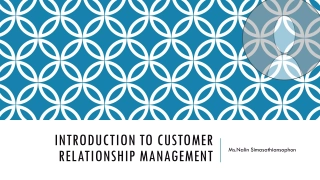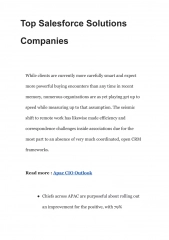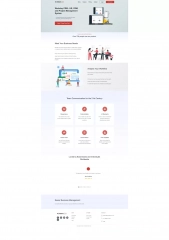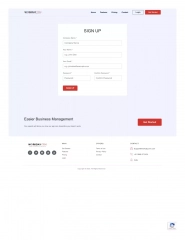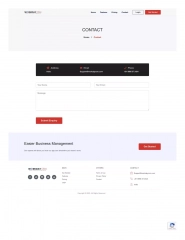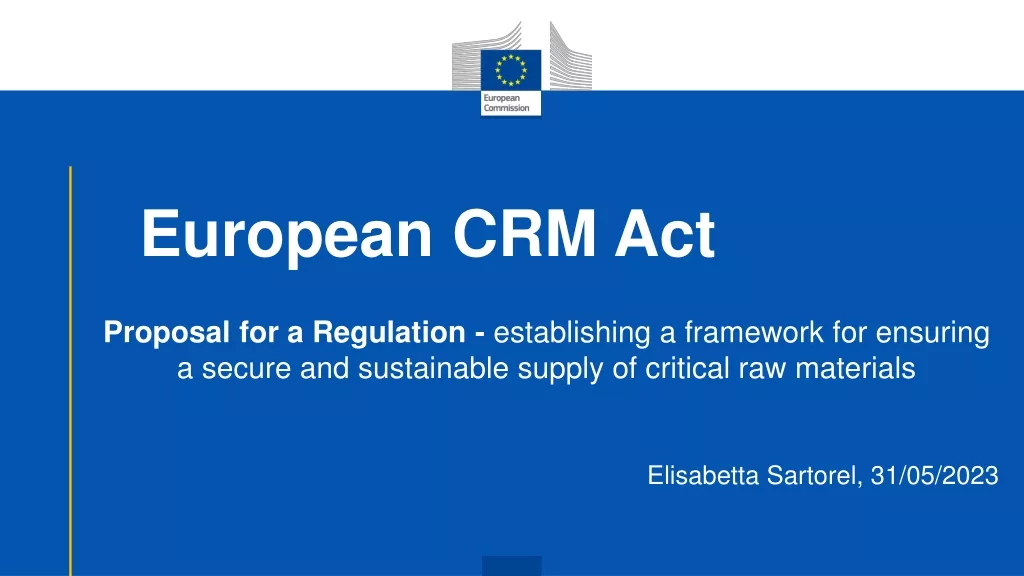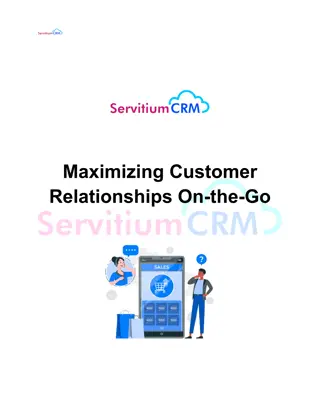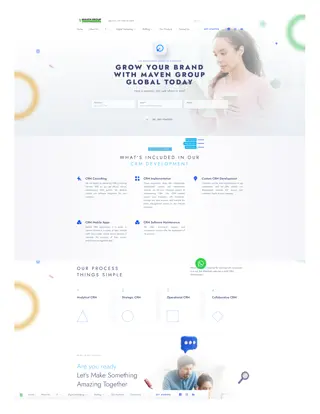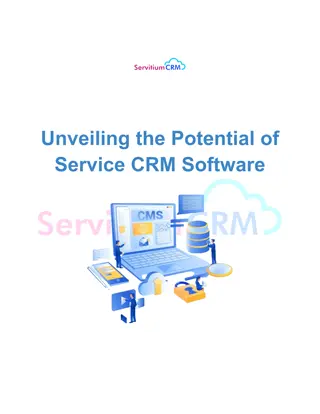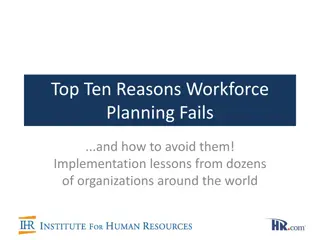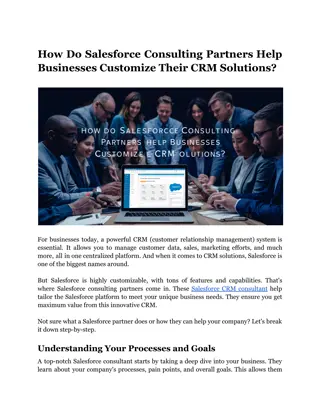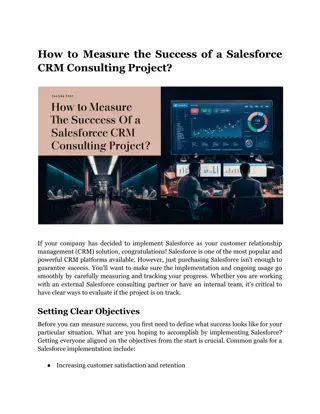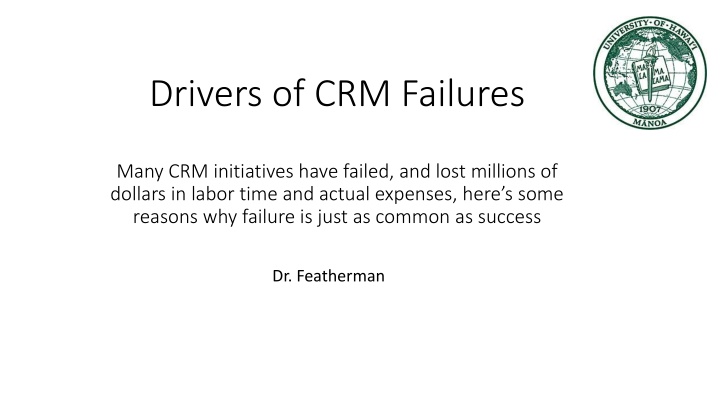
Exploring CRM Failure Drivers
Many CRM initiatives fail due to various reasons such as lack of ROI quantification, focus on manipulation rather than service, misplaced emphasis on enterprise-level expansions, and challenges in system utilization. Successful CRM implementation requires a focus on customer service, incremental investments, organizational improvements, and tailored processes rather than a one-size-fits-all approach.
Download Presentation

Please find below an Image/Link to download the presentation.
The content on the website is provided AS IS for your information and personal use only. It may not be sold, licensed, or shared on other websites without obtaining consent from the author. If you encounter any issues during the download, it is possible that the publisher has removed the file from their server.
You are allowed to download the files provided on this website for personal or commercial use, subject to the condition that they are used lawfully. All files are the property of their respective owners.
The content on the website is provided AS IS for your information and personal use only. It may not be sold, licensed, or shared on other websites without obtaining consent from the author.
E N D
Presentation Transcript
Drivers of CRM Failures Many CRM initiatives have failed, and lost millions of dollars in labor time and actual expenses, here s some reasons why failure is just as common as success Dr. Featherman
Drivers of CRM Failure First many IT and CRM improvement projects don t even get approved If finance is controlling the budgets and top management doesn t really understand technology anyway, it is very hard to quantify ROI and payback for any large IT effort. So finance says NO The consumer acquisition process is not orderly and the argument can be made that increased sharing of information is a good thing, but its impossible to quantify and then measure how performance improved. So no ROI. Its na ve for a firm puts its hopes in some software to fix it s customer facing processes then there is underlying chaos (a new house, etc. won t fix a bad marriage)
Drivers of CRM Failure Is the basic premise for buying the software even correct? More information about the client allows us to market to them (manipulate them) better this is a payback approach. We spend X dollars to get a payback in Y years due to increased transactions. Customers do not want to be manipulated or managed they just want better service. Why not sell the software and org change on that and make the implementation focused on that? Are we using data to control customers (Pepe story) or using data to serve them better? If a firm really wants to serve our customers then there is no concern for payback. Just do it. But do you need CRM software or just better internal processes to share information?
Drivers of CRM Failure CRM systems should listen and serve why is there a focus on expanding them to enterprise level? The ROI return is contingent on what you learn from your customers and how you react, operational efficiencies, and the internal competencies gained. This means you can install software and not get a payback if you do not use the system well Better to invest light (venture capital model round 1,2,3 financing) module by module, then build up, rather than go big bang at first. Each module or process is complex and probably cross-functional so you can t change too much all at once (a sure way to fail anything) CRM is not a quick solution or a quick fix, it is a process that is creative destruction
Drivers of CRM Failure CRM benefits are contingent on use of system and shared use of the system, and development of capabilities. This is an org improvement derived from the software Sales reps do not want to be commoditized like IT workers CRM processes imposed countrywide or org-wide can thwart individual or regional unique needs conforming each office to the national version of the software can reduce specialization. One size does not fit all. Localization efforts in processes can be removed CRM may have overlapping functionality with back office software, so where do you do the data entry? This needs to be organized, also integration is painful and expensive
Drivers of CRM Failure CRM benefits the entire company and the power is in data organization and sharing from one dept. to the next. No employee will get very excited about CRM benefits (they see loss not gain), only top mgmt. An overall system (MS-office) is never as good as special purpose software but the payback is in using the suite of apps/functionality. So the ROI will come if many features are widely used (which raises the bar for ROI) Since meaningful CRM usage is semi-voluntary, be sure to change job descriptions that specify what screens and functionality are required. This means however that job descriptions are in perpetual beta version This means that employee s lives are being changed often which is unsettling for many
Drivers of CRM Failure CRM implementation starts with managers with process knowledge. They can then map current processes into the new software CRM success is contingent on user adoption, and deep adoption breadth and depth of usage Sales reps are goal driven and are not bound to a tool. Any tool that slows them down is bad..so make sure it doesn t! Data integrity problems can make CRM reports worthless CRM success is too dependent on employee diligence, goodwill and skill of the users. Creatives are not the same detail oriented nature as back office types
Drivers of CRM Failure Activity can increase but productivity can decrease Many prospects will never buy, so do their names need to be in the CRM system cluttering up the picklists and requiring maintenance? Salesreps need to turn the wheels of commerce, so a slowdown in orders can hurt he company, and then there is less profits for salary Data entry/edits/maintenance are no fun for customer-facing employees CRM is too rigid and complicated regardless of marketing videos CRM systems are difficult to install, tweak, fix and maintain. Regarding customization other than just UI, its just another scripting langage that is not taught at the university so IT workers are not excited to learn it
Drivers of CRM Failure Midsize companies do not have IT staff so who will handle implementation? Training, data modeling and transfer, process changes all take way longer than you would expect. In fact data migration is the hardest technical part of the implementation because it can t be automated. Good luck getting data from legacy ERP systems or messy Excel file (where it is common that each person with the excel file uses whatever column names they want) Data needs to be cleaned, reformatted, and placed into a data model with dimension tables (textual data, such as categories) and fact tables (numeric measures and dates)
Drivers of CRM Failure While most employees will focus on the CRM interface and discuss what options should be available and how screen formats are organized, the real pain is in data migration The first step of data migration is to understand the current data but that depends on - different people s files and column names, etc. - Different region s peculiarities in data storage - Different product lines can have different naming conventions - Different data types and file types - Different departments have much different data needs - count on a mess and lack of data organization (all data thrown together without organization or separation of textual categories and numeric measures
Data movement steps Gather and Understand the current data Clean, re-calculate and organize the current data (problems!!) Create a data model of the current data Import the current data into a database Map columns from different tables into the data model Fix mapping errors, run a test script to move data from current files into a database, fix migration errors, repeat Load all data into database (create temporary data entry system, discard old files) Examine new CRM database tables, map data from database to new CRM system Add measures of derived data KPI s (test and validate accuracy of KPI measures Begin to use CRM system for data entry Integrate CRM with other existing legacy systems (repeat mapping and migration) Test validate everything
Drivers of CRM Failure Organizational Politics CRM is am IT and therefore more commonly controlled by back office departments (IT/OPS/ACCTG/HR). The CRM initiative (using more technology in daily processes) may be viewed as an attempt to control other departments. There will be a loss of autonomy in the customer facing departments and they may just choose to partially adopt the CRM software, making the reports worthless with the result of management being frustrated. While back office management is most adept at using new technologies and conforming processes to the IT (and leveraging it), they should share the lead of the project or sty in the background so the project is led by management of the departments that are affected
Drivers of CRM failure With the focus on analytics, CRM implementers may want much more data entry from Marketing and Sales, which can in the long run help, but in the myopic short run, take time away from revenue generating activities CRM = ERP for the front office, but front office types are self centered not org centered so why should they care? Internal struggles and implementation troubles all take the attention away from the customer (this is antithetic to the value proposition) We need software to make the back office and front office more customer centric CRM is not a standalone system so it needs to be integrated into the rest of the firm s software more expense
Drivers of CRM failure IT people are lukewarm to any software they dis not create and they also fear loss of power to external vendors (are we replacing IT workers with vendor software?....yes) Therefore IT workers may have lukewarm support of CRM and like that it fails IT will be a struggle to implement and you need strong, charismatic leadership when things go wrong Data synchronization how do 2 workers simultaneously update the same customer record? CRM is perpetual betaware which is not appreciated by most employees, especially less IT savvy, less secure in their position, and older employees (whom have more power) There is so much access to data about products, customers, deals it isoverwhelming and hopefully your data is not stolen!
Final comments Do your homework about CRM Maybe grow org conformity and info sharing with existing systems. There may be features of current systems (or modules that can be added to current systems) that can provide similar benefits Fix internal data sharing, data modeling, reporting issues, document processes get the front office house in order this alone may reap desired benefits Implement slowly after house cleaning and allow customization to ensure creativity is not destroyed. Implement in a small region and learn from it before going into the next region

